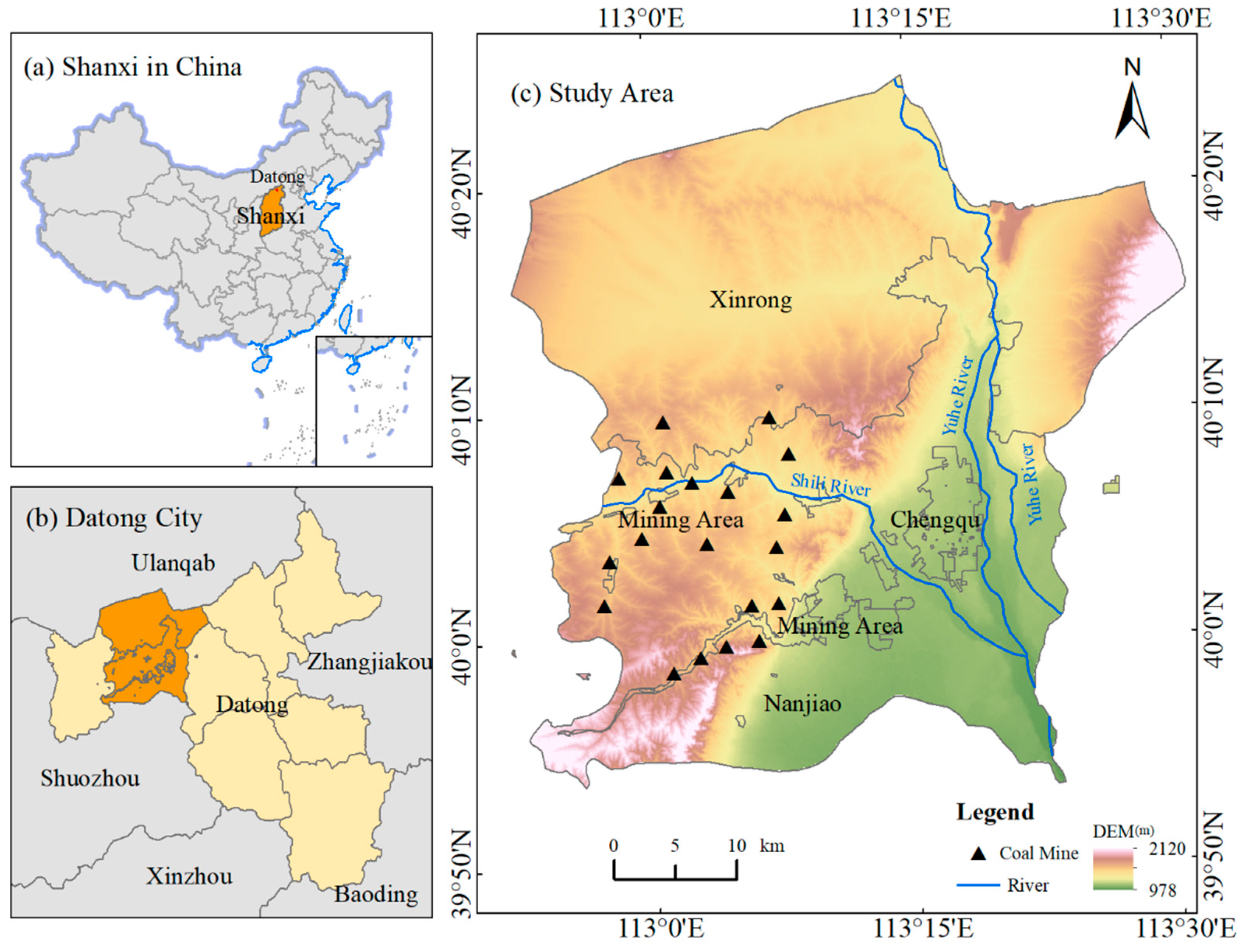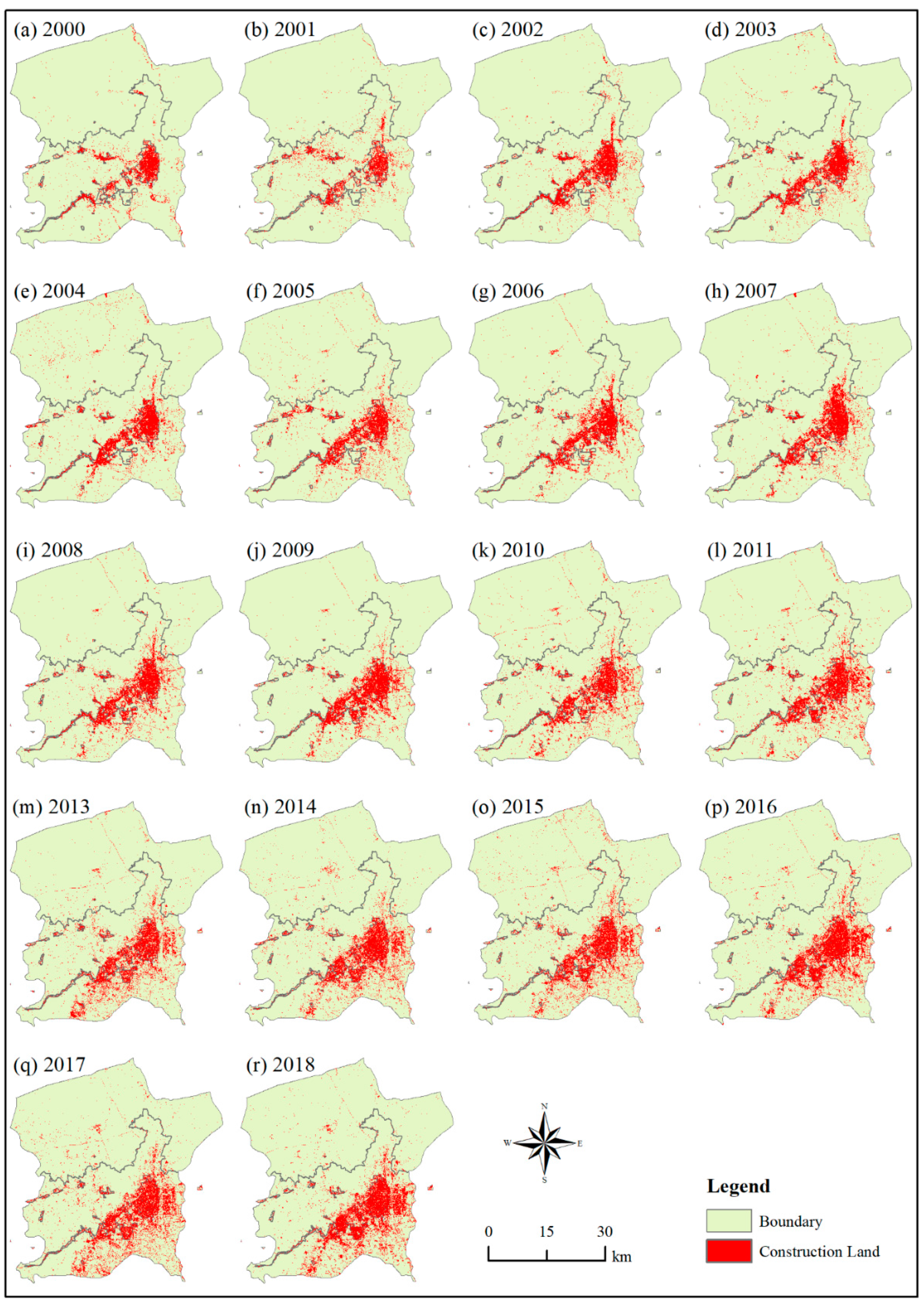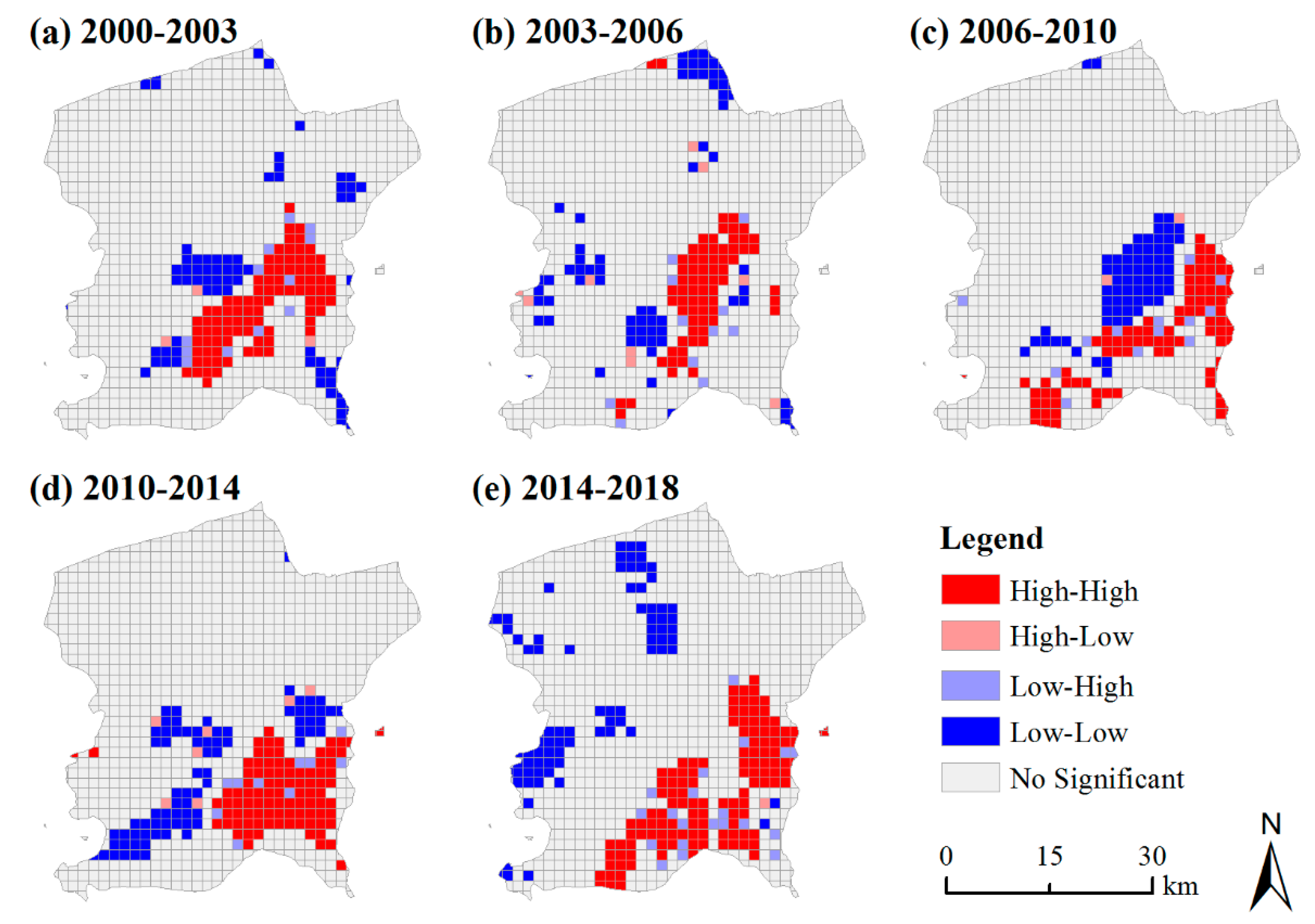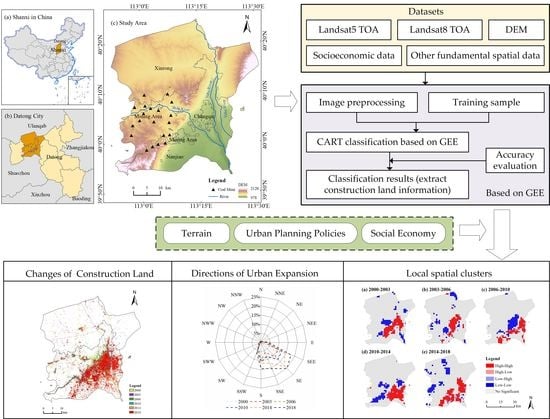Expansion and Evolution of a Typical Resource-Based Mining City in Transition Using the Google Earth Engine: A Case Study of Datong, China
Abstract
:1. Introduction
2. Materials and Methods
2.1. Study Area
2.2. Data Source and Processing
2.3. Data Analysis
2.3.1. Statistical Analysis
2.3.2. Expansion Direction Analysis
2.3.3. Spatial Cluster Analyses
3. Results
3.1. Changes of Urban Construction Land
3.2. Directions of Urban Expansion
3.3. Spatial Patterns of Urban Expansion
4. Discussion
5. Conclusions
Author Contributions
Funding
Institutional Review Board Statement
Informed Consent Statement
Data Availability Statement
Acknowledgments
Conflicts of Interest
References
- NBSC. China Statistical Yearbook-2020; China Statistic Press: Beijing, China, 2020.
- NBSC. China Statistical Yearbook-2000; China Statistic Press: Beijing, China, 2000.
- Gu, C.; Wei, Y.D.; Cook, I.G. Planning Beijing: Socialist city, transitional city, and global city. Urban. Geogr. 2015, 36, 905–926. [Google Scholar] [CrossRef]
- Wei, Y.D. Regional Development in China: States, Globalization and Inequality; Routledge: London, UK, 2000. [Google Scholar]
- Wu, F. Emerging Chinese Cities: Implications for Global Urban Studies. Prof. Geogr. 2016, 68, 338–348. [Google Scholar] [CrossRef]
- Healey, P. Urban Complexity and Spatial Strategies: Towards a Relational Planning for Our Times; Routledge: London, UK, 2006. [Google Scholar]
- Masek, J.G.; Lindsay, F.E.; Goward, S.N. Dynamics of urban growth in the Washington DC metropolitan area, 1973–1996, from Landsat observations. Int. J. Remote Sens. 2000, 21, 3473–3486. [Google Scholar] [CrossRef]
- Morshed, N.; Yorke, C.; Zhang, Q. Urban Expansion Pattern and Land Use Dynamics in Dhaka, 1989–2014. Prof. Geogr. 2016, 69, 1–16. [Google Scholar] [CrossRef]
- Chen, J.; Gao, J.; Chen, W. Urban land expansion and the transitional mechanisms in Nanjing, China. Habitat Int. 2016, 53, 274–283. [Google Scholar] [CrossRef]
- Cao, Y.; Zhang, X.L.; Fu, Y.; Lu, Z.W.; Shen, X.Q. Urban spatial growth modeling using logistic regression and cellular automata: A case study of Hangzhou. Ecol. Indic. 2020, 113, 106200. [Google Scholar] [CrossRef]
- Wu, W.; Zhao, S.; Zhu, C.; Jiang, J. A comparative study of urban expansion in Beijing, Tianjin and Shijiazhuang over the past three decades. Landsc. Urban. Plan. 2015, 134, 93–106. [Google Scholar] [CrossRef]
- Sun, W.; Shan, J.; Wang, Z.; Wang, L.; Lu, D.; Jin, Z.; Yu, K. Geospatial analysis of urban expansion using remote sensing methods and data: A case study of Yangtze River Delta, China. Complexity 2020, 2020, 3239471. [Google Scholar] [CrossRef]
- Seto, K.C.; Fragkias, M. Quantifying spatiotemporal patterns of urban land-use change in four cities of China with time series landscape metrics. Landsc. Ecol. 2005, 20, 871–888. [Google Scholar] [CrossRef]
- Wohlfart, C.; Mack, B.; Liu, G.; Kuenzer, C. Multi-faceted land cover and land use change analyses in the Yellow River Basin based on dense Landsat time series: Exemplary analysis in mining, agriculture, forest, and urban areas. Appl. Geogr. 2017, 85, 73–88. [Google Scholar] [CrossRef]
- Zhou, Q. Climatic data analysis and computer data simulation of inland cities based on cloud computing and remote sensing images. Arab. J. Geosci. 2021, 14, 1010. [Google Scholar] [CrossRef]
- Huang, H.; Chen, W.; Zhang, Y.; Qiao, L.; Du, Y. Analysis of ecological quality in Lhasa Metropolitan Area during 1990–2017 based on remote sensing and Google Earth engine platform. J. Geogr. Sci. 2021, 31, 265–280. [Google Scholar] [CrossRef]
- Beaton, A.; Whaley, R.; Corston, K.; Kenny, F. Identifying historic river ice breakup timing using MODIS and Google Earth Engine in support of operational flood monitoring in Northern Ontario. Remote Sens. Environ. 2019, 224, 352–364. [Google Scholar] [CrossRef]
- Liu, Z.; Liu, H.; Luo, C.; Yang, H.; Meng, X.; Ju, Y.; Guo, D. rapid extraction of regional-scale agricultural disasters by the standardized monitoring model based on Google Earth engine. Sustainability 2020, 12, 6497. [Google Scholar] [CrossRef]
- Scheip, C.M.; Wegmann, K.W. HazMapper: A global open-source natural hazard mapping application in Google Earth Engine. Nat. Hazards Earth Syst. Sci. 2021, 21, 1495–1511. [Google Scholar] [CrossRef]
- Tamiminia, H.; Salehi, B.; Mahdianpari, M.; Quackenbush, L.; Adeli, S.; Brisco, B. Google Earth Engine for geo-big data ap-plications: A meta-analysis and systematic review. ISPRS J. of Photogramm. 2020, 164, 152–170. [Google Scholar] [CrossRef]
- Xie, Z.; Phinn, S.R.; Game, E.T.; Pannell, D.J.; Hobbs, R.J.; Briggs, P.R.; McDonald-Madden, E. Using Landsat observations (1988–2017) and Google Earth Engine to detect vegetation cover changes in rangelands—A first step towards identifying degraded lands for conservation. Remote Sens. Environ. 2019, 232, 111317. [Google Scholar] [CrossRef]
- Brovelli, M.A.; Sun, Y.; Yordanov, V. Monitoring forest change in the Amazon using multi-temporal remote sensing data and machine learning classification on Google Earth engine. ISPRS Int. J. Geo-Inform. 2020, 9, 580. [Google Scholar] [CrossRef]
- Yang, X.; Chen, Y.; Wang, J. Combined use of Sentinel-2 and Landsat 8 to monitor water surface area dynamics using Google Earth engine. Remote Sens. Lett. 2020, 11, 687–696. [Google Scholar] [CrossRef]
- Weekley, D.; Li, X. Tracking multidecadal lake water dynamics with landsat imagery and topography/bathymetry. Water Resour. Res. 2019, 55, 8350–8367. [Google Scholar] [CrossRef]
- Luo, C.; Liu, H.-J.; Lu, L.-P.; Liu, Z.-R.; Kong, F.-C.; Zhang, X.-L. Monthly composites from Sentinel-1 and Sentinel-2 images for regional major crop mapping with Google Earth Engine. J. Integr. Agric. 2021, 20, 1944–1957. [Google Scholar] [CrossRef]
- Dong, J.; Xiao, X.; Menarguez, M.A.; Zhang, G.; Qin, Y.; Thau, D.; Biradar, C.; Moore, B., III. Mapping paddy rice planting area in northeastern Asia with Landsat 8 images, phenology-based algorithm and Google Earth Engine. Remote Sens. Environ. 2016, 185, 142–154. [Google Scholar] [CrossRef] [Green Version]
- Zeng, H.; Wu, B.; Wang, S.; Musakwa, W.; Tian, F.; Mashimbye, Z.E.; Poona, N.; Syndey, M. A synthesizing land-cover classification method based on Google Earth engine: A case study in Nzhelele and Levhuvu Catchments, South Africa. Chin. Geogr. Sci. 2020, 30, 397–409. [Google Scholar] [CrossRef]
- Zhang, D.-D.; Zhang, L. Land cover change in the central region of the Lower Yangtze river based on landsat imagery and the Google Earth engine: A case study in Nanjing, China. Sensors 2020, 20, 2091. [Google Scholar] [CrossRef] [PubMed] [Green Version]
- Zhang, J.; Yu, L.; Li, X.; Zhang, C.; Shi, T.; Wu, X.; Yang, C.; Gao, W.; Li, Q.; Wu, G. Exploring annual urban expansions in the Guangdong-Hong Kong-Macau Greater Bay area: Spatiotemporal features and driving factors in 1986–2017. Remote Sens. 2020, 12, 2615. [Google Scholar] [CrossRef]
- Shatnawi, N.; Weidner, U.; Hinz, S. Monitoring urban expansion as a result of refugee fluxes in north jordan using remote sensing techniques. J. Urban. Plan. Dev. 2020, 146, 04020026. [Google Scholar] [CrossRef]
- Cao, W.; Zhou, Y.; Li, R.; Li, X.; Zhang, H. Monitoring long-term annual urban expansion (1986–2017) in the largest archipelago of China. Sci. Total Environ. 2021, 776, 146015. [Google Scholar] [CrossRef]
- Datong City Statistics Bureau; National Bureau of Statistics Datong Investigation Team. Datong Statistical Yearbook (2018); China Statistic Press: Beijing, China, 2018.
- Chen, J.; Chen, J.; Liao, A.P.; Cao, X.; Chen, L.J.; Chen, X.H.; Peng, S.; Han, G.; Zhang, H.W.; He, C.Y.; et al. Concepts and key techniques for 30m globale land cover mapping. Acta Geod. Cartogr. Sin. 2014, 43, 551–557. (In Chinese) [Google Scholar]
- Breiman, L.; Friedman, J.; Stone, C.J.; Olshen, R.A. Classification and Regression Trees; Chapman and Hall: New York, NY, USA, 1984. [Google Scholar]
- Wei, S. Mapping cropland abandonment in mountainous areas using an annual land-use trajectory approach. Sustainability 2019, 11, 5951. [Google Scholar]
- Sang, X.; Guo, Q.; Wu, X.; Fu, Y.; Xie, T.; He, C.; Zang, J. Intensity and stationarity analysis of land use change based on CART algorithm. Sci. Rep. 2019, 9, 12279. [Google Scholar] [CrossRef] [Green Version]
- Hu, Y.F.; Shang, L.J.; Zhang, Q.L.; Wang, Z.H. Land change patterns and driving mechanism in Beijing Since 1990 based on GEE platform. Remote Sens. Technol. Appl. 2018, 33, 573–583. (In Chinese) [Google Scholar]
- Zha, Y.; Gao, J.; Ni, S. Use of normalized difference built-up index in automatically mapping urban areas from TM imagery. Int. J. Remote Sens. 2003, 24, 583–594. [Google Scholar] [CrossRef]
- Landis, J.R.; Koch, G.G. The measurement of observer agreement for categorical data. Biometrics 1977, 33, 159–174. [Google Scholar] [CrossRef] [PubMed] [Green Version]
- Li, Z.L.; Kuang, W.H.; Zhang, S. Remote sensing monitoring and spatiotemporal pattern of land use/cover change in built-up area of Tianjin in the past 70 years. Remote Sens. Technol. Appl. 2020, 35, 527–536. (In Chinese) [Google Scholar]
- Li, S.; He, Y.; Xu, H.; Zhu, C.; Dong, B.; Lin, Y.; Si, B.; Deng, J.; Wang, K. Impacts of urban expansion forms on ecosystem services in urban agglomerations: A case study of Shanghai-Hangzhou Bay urban agglomeration. Remote Sens. 2021, 13, 1908. [Google Scholar] [CrossRef]
- Wang, H.; Zhang, B.; Liu, Y.; Liu, Y.; Xu, S.; Zhao, Y.; Chen, Y.; Hong, S. Urban expansion patterns and their driving forces based on the center of gravity-GTWR model: A case study of the Beijing-Tianjin-Hebei urban agglomeration. J. Geogr. Sci. 2020, 30, 297–318. [Google Scholar] [CrossRef]
- Moran, P.A.P. Notes on continuous stochastic phenomena. Biometrika 1950, 37, 17–23. [Google Scholar] [CrossRef]
- Pan, P.; Sun, Y.; Ouyang, X.; Zang, H.; Rao, J.; Ning, J. Factors affecting spatial variation in vegetation carbon density in Pinus massoniana Lamb. Forest in Subtropical China. Forests 2019, 10, 880. [Google Scholar] [CrossRef] [Green Version]
- Anselin, L. Local indicators of spatial association—LISA. Geogr. Anal. 1995, 27, 93–115. [Google Scholar] [CrossRef]
- Ha, K.; Ding, Q.L.; Men, M.X.; Xu, H. Spatial distribution of land use and its relationship with terrain factors in hilly area. Geogr. Res. 2015, 34, 909–921. (In Chinese) [Google Scholar]
- Zhao, M.; Cheng, W.; Liu, Q.; Wang, N. Spatiotemporal measurement of urbanization levels based on multiscale units: A case study of the Bohai Rim Region in China. J. Geogr. Sci. 2016, 26, 531–548. [Google Scholar] [CrossRef] [Green Version]
- Luan, W.; Li, X. Rapid urbanization and its driving mechanism in the Pan-Third Pole region. Sci. Total Environ. 2021, 750, 141270. [Google Scholar] [CrossRef]
- Tian, L.; Li, Y.; Yan, Y.; Wang, B. Measuring urban sprawl and exploring the role planning plays: A shanghai case study. Land Use Policy 2017, 67, 426–435. [Google Scholar] [CrossRef]
- Central People’s Government of the People’s Republic of China. Available online: http://www.gov.cn/zhengce/con-tent/2008-03/28/content_5507.htm (accessed on 16 July 2021). (In Chinese)
- Pan, H. Preparations for the protection and restoration of the ancient city. Datong Daily, 23 May 2008. (In Chinese) [Google Scholar]
- Wang, Y. The city plans to transform 74 old residential areas in urban areas this year. Datong Daily, 15 March 2016. (In Chinese) [Google Scholar]
- Li, C.; Sun, T.; Zhai, L.; Yuan, K. City profile: Datong, China. Environ. Urban. ASIA 2019, 10, 176–192. [Google Scholar] [CrossRef]
- Yang, Q. RS and GIS-based urban expansion in Nantong area, China: Pattern, characteristic and dring force variance. Remote Sens. Technol. Appl. 2011, 26, 365–374. (In Chinese) [Google Scholar]







| Year | Data Type | Data ID | Overall Accuracy (%) | Kappa |
|---|---|---|---|---|
| 2000 | Landsat 5 TOA | LT05_125032_20000506 | 95.49% | 0.89 |
| 2001 | Landsat 5 TOA | LT05_125032_20011101 | 94.29% | 0.70 |
| 2002 | Landsat 5 TOA | LT05_125032_20020901 | 97.62% | 0.89 |
| 2003 | Landsat 5 TOA | LT05_125032_20030819 | 97.30% | 0.86 |
| 2004 | Landsat 5 TOA | LT05_125032_20040805 | 95.62% | 0.79 |
| 2005 | Landsat 5 TOA | LT05_125032_20050925 | 93.36% | 0.68 |
| 2006 | Landsat 5 TOA | LT05_125032_20060827 | 96.31% | 0.78 |
| 2007 | Landsat 5 TOA | LT05_125032_20070915 | 96.67% | 0.81 |
| 2008 | Landsat 5 TOA | LT05_125032_20080901 | 96.68% | 0.80 |
| 2009 | Landsat 5 TOA | LT05_125032_20090920 | 96.51% | 0.77 |
| 2010 | Landsat 5 TOA | LT05_125032_20100705 | 96.57% | 0.79 |
| 2011 | Landsat 5 TOA | LT05_125032_20110521 | 97.37% | 0.81 |
| 2013 | Landsat 8 TOA | LC08_125032_20130627 | 96.48% | 0.74 |
| 2014 | Landsat 8 TOA | LC08_125032_20140918 | 97.00% | 0.82 |
| 2015 | Landsat 8 TOA | LC08_125032_20150804 | 96.07% | 0.77 |
| 2016 | Landsat 8 TOA | LC08_125032_20161025 | 97.33% | 0.82 |
| 2017 | Landsat 8 TOA | LC08_125032_20170825 | 96.66% | 0.83 |
| 2018 | Landsat 8 TOA | LC08_125032_20181031 | 95.96% | 0.79 |
| 2000–2003 | 2003–2006 | 2006–2010 | 2010–2014 | 2014–2018 | |
|---|---|---|---|---|---|
| Chengqu | 1.00 | 0.47 | −0.40 | 0.78 | 0.62 |
| Mining Area | 1.35 | −0.47 | 1.65 | 0.02 | 0.61 |
| Nanjiao | 6.66 | 5.30 | 2.13 | 5.01 | 7.69 |
| Xinrong | 0.64 | −0.25 | 1.33 | 0.11 | −0.05 |
| Study Area | 9.66 | 5.05 | 4.71 | 5.92 | 8.88 |
| 2000 | 2003 | 2006 | 2010 | 2014 | 2018 | |
|---|---|---|---|---|---|---|
| Chengqu | 65.36 | 71.62 | 74.55 | 71.18 | 77.66 | 82.84 |
| Mining Area | 32.30 | 41.33 | 38.17 | 52.83 | 53.01 | 58.46 |
| Nanjiao | 4.33 | 6.37 | 8.00 | 8.87 | 10.93 | 14.07 |
| Xinrong | 0.39 | 0.58 | 0.51 | 1.04 | 1.08 | 1.06 |
| Study Area | 4.45 | 5.85 | 6.58 | 7.49 | 8.63 | 10.35 |
| 2000 | 2003 | 2006 | 2010 | 2014 | 2018 | |
|---|---|---|---|---|---|---|
| Value of Moran’s I | 0.9961 | 0.8220 | 0.8334 | 0.8139 | 0.8678 | 0.8656 |
| p-value | 0.00 | 0.00 | 0.00 | 0.00 | 0.00 | 0.00 |
Publisher’s Note: MDPI stays neutral with regard to jurisdictional claims in published maps and institutional affiliations. |
© 2021 by the authors. Licensee MDPI, Basel, Switzerland. This article is an open access article distributed under the terms and conditions of the Creative Commons Attribution (CC BY) license (https://creativecommons.org/licenses/by/4.0/).
Share and Cite
Xue, M.; Zhang, X.; Sun, X.; Sun, T.; Yang, Y. Expansion and Evolution of a Typical Resource-Based Mining City in Transition Using the Google Earth Engine: A Case Study of Datong, China. Remote Sens. 2021, 13, 4045. https://doi.org/10.3390/rs13204045
Xue M, Zhang X, Sun X, Sun T, Yang Y. Expansion and Evolution of a Typical Resource-Based Mining City in Transition Using the Google Earth Engine: A Case Study of Datong, China. Remote Sensing. 2021; 13(20):4045. https://doi.org/10.3390/rs13204045
Chicago/Turabian StyleXue, Minghui, Xiaoxiang Zhang, Xuan Sun, Tao Sun, and Yanfei Yang. 2021. "Expansion and Evolution of a Typical Resource-Based Mining City in Transition Using the Google Earth Engine: A Case Study of Datong, China" Remote Sensing 13, no. 20: 4045. https://doi.org/10.3390/rs13204045
APA StyleXue, M., Zhang, X., Sun, X., Sun, T., & Yang, Y. (2021). Expansion and Evolution of a Typical Resource-Based Mining City in Transition Using the Google Earth Engine: A Case Study of Datong, China. Remote Sensing, 13(20), 4045. https://doi.org/10.3390/rs13204045







